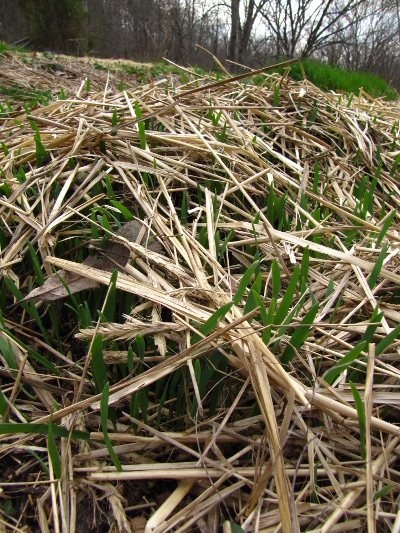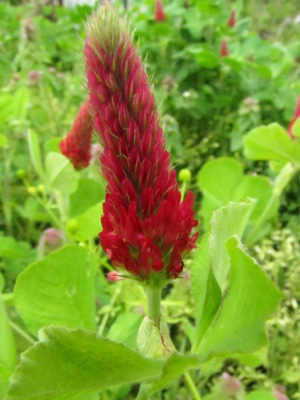
Warm-winter cover-crop question
 I got a great comment from
asaf this week, and I'd like to answer it here bit by bit just in case
another Southerner is considering a similar cover-crop experiment.
I got a great comment from
asaf this week, and I'd like to answer it here bit by bit just in case
another Southerner is considering a similar cover-crop experiment.
"Goals: weed suppression, soil improvement, erosion control. Crop: 1. oats/vetch/clover. 2. oats for straw.
"The ground will be lightly plowed after the first rains in mid October. I plan to hand-broadcast the seeds and need a good solution for how to cover them afterwards."
I've had good luck
simply sprinkling a light coating of straw over the ground after
broadcasting cover-crop seeds. The straw is enough to confuse the birds
and keep the seeds damp as they germinate, but not enough to prevent
the seedlings from growing toward the light. The photo above, from Homegrown
Humus, shows the
density of straw I recommend.
Now, back to asaf....
"Essentially, I will be creating a 1/5 acre compost pile that is low enough to not necessitate turning and covered by straw on top to preserve moisture and smother the cover crop.
"I plant to plant a variety of vegetables into this. The bulk will be corn into the vetch rows, and peanuts into the pure oat rows. Might do a batch of radishes before the peanuts as a quick spring crop to suppress nematodes."
Unfortunately,
smother-killing is going to be a tough call for the species mixtures
you plan. Most clovers and vetches are perennials, which means they'll
grow back vigorously after cutting. And in your Deep South location,
the oats aren't going to naturally winter-kill for you the way they do
here.
In your shoes, I'd
recommend some combination of the following:
 Your pure-oats area will be the
easiest to manage. If you wait
until the oats achieve full bloom and then mow them very close to the
ground, they will hopefully die for you. I haven't done this myself
since our oats naturally winter-kill, but we
use this method with rye
with good success.
Your pure-oats area will be the
easiest to manage. If you wait
until the oats achieve full bloom and then mow them very close to the
ground, they will hopefully die for you. I haven't done this myself
since our oats naturally winter-kill, but we
use this method with rye
with good success.
- If you tweak your legume species a bit, you might have better luck ensuring they perish on command. Crimson clover is an annual that is reputed to mow-kill reliably at bloom. I haven't tried that myself, but my father (in zone 8) has told me that his crimson clover naturally dies after going to seed, then the seeds don't sprout back until the fall. So you might get away with letting crimson clover become a no-work, winter cover crop that comes back year after year.
- If all else fails, you can solarize your
cover crops after cutting them close to the ground in the spring.
This is probably more realistic on your scale than the kill mulches I
use on smaller expanses of plants-that-refuse-to-die.
I hope that helps, and I
also hope you'll report back with some pictures and notes as your
experiment progresses! I adore cover-crop experiments and would love to
see how yours pans out.
Want more in-depth information? Browse through our books.
Or explore more posts by date or by subject.
About us: Anna Hess and Mark Hamilton spent over a decade living self-sufficiently in the mountains of Virginia before moving north to start over from scratch in the foothills of Ohio. They've experimented with permaculture, no-till gardening, trailersteading, home-based microbusinesses and much more, writing about their adventures in both blogs and books.
Want to be notified when new comments are posted on this page? Click on the RSS button after you add a comment to subscribe to the comment feed, or simply check the box beside "email replies to me" while writing your comment.
- Remove comment
- Remove comment
